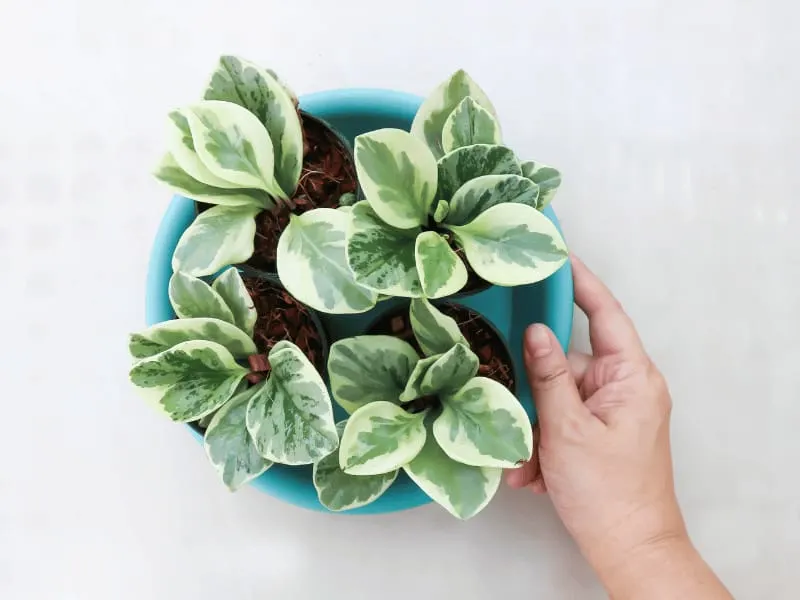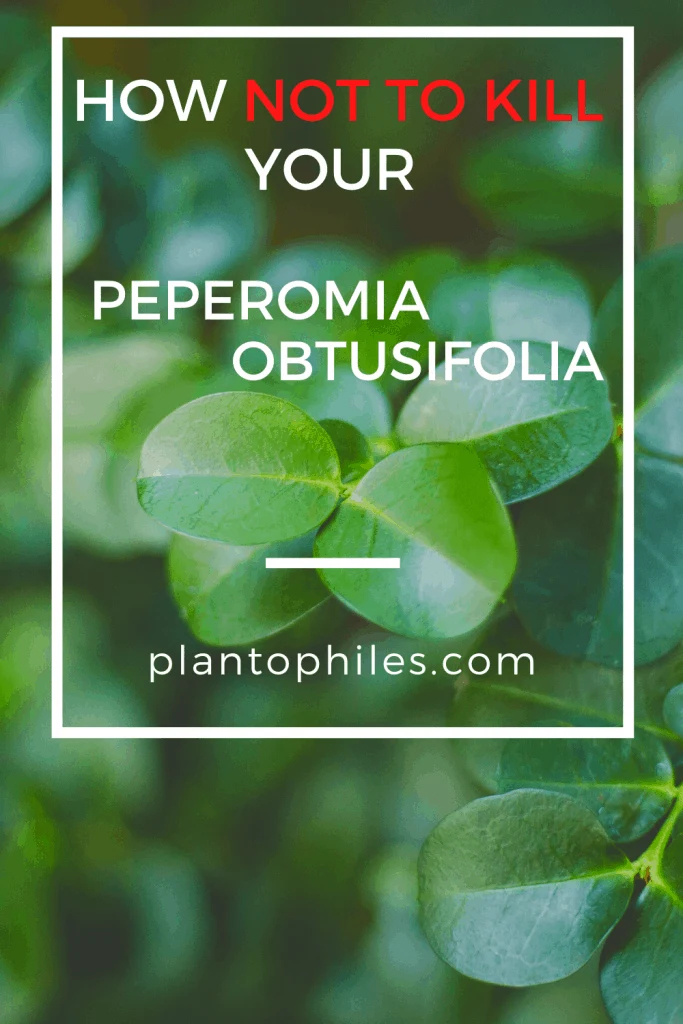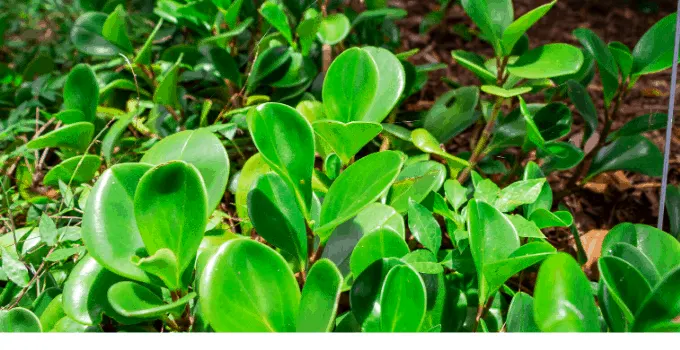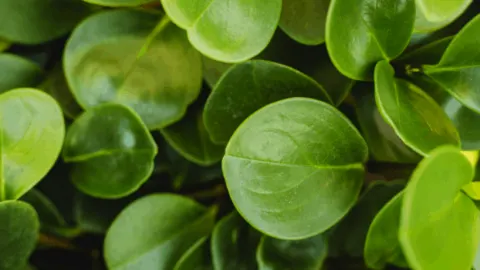Peperomia obtusifolia with its fleshy, dark green leaves, is one of the more popular Peperomia species commonly grown as a houseplant. Here is how to care for it.
Peperomia obtusifolia
Peperomia obtusifolia is native to Florida, Mexico, and the Caribbean. It is also called Baby Rubber Plant and Pepper Face. There are more than 1600 Peperomia species.

Summary: 5 Baby Rubber Plant Care Tips
1. Don’t overwater your Peperomia
2. In summer, leach the soil of your Peperomia obtusifolia to remove excess salts in the soil
3. The light requirements for your Peperomia depend on the nature of your plant: If you have a plant with green leaves only, a location with moderate to bright sunlight will be best. If you do have a Peperomia obtusifolia with multi-colored (variegated) leaves, a brighter spot will be favorable ( a few hours of morning and evening sun are fine, but hot midday sun should be omitted, as this will the leaves of your plant).
4. Temperatures below 15 degrees (over an extended period) will harm your plant. The ideal temperature range for your Baby Rubber plant is between 18 and 23 degrees (64 to 73 Fahrenheit).
5. Always use pots with drainage holes. Proper drainage is essential to ensure the well-being of the Peperomia obtusifolia.
Table of Contents
Takeaways
| Species | Peperomia obtusifolia |
|---|---|
| Synonyms | Baby Rubber Plant, American Rubber Plant, Baby Rubber Plant, Oval Leaf Peperomia, Pepper Face, Rhynchophorum |
| Family | Piperaceae |
| Genus | Peperomia |
| Growth | Compact, bushy |
| Height | 1ft / 0.3m |
| Width | 1ft / 0.3m |
| Soil | Well-draining potting mix |
| Watering | Every 7 – 14 days |
| Light | Bright indirect |
| Temperature | 60 – 80°F / 15.6 – 26.7°C |
| Humidity | 40 – 60% |
| Fertilizer | Once a month |
| Propagation | Stem cuttings or leaf cuttingsdescription: Peperomia obtusifolia is a compact and bushy plant with thick, glossy leaves. It is an easy-to-care-for houseplant that adds a touch of green to any space. |
| Toxicity | Non-toxic to humans, cats and dogs |
Peperomia obtusifolia Care – My Best Tips
Soil Needs to be Well-Draining
Well-draining soil is a must. Oxygen to the roots is crucial. Use a chunky mix with peat, perlite, and orchid bark.
Leach the soil from time to time. This serves to remove the excess salts in the soil. You can do that once or twice every summer.

Light Should be Bright but Indirect
Peperomia obtusifolia does best in bright indirect sunlight.
The plant does not tolerate direct sunlight. It will burn the leaves.
If you are unsure what low & moderate light means, read my article on light levels.
Watering When The Soil Is Dry
Water your Peperomia whenever the top layers of the soil dry out. The general rule of thumb here is that the soil’s surface (top layers) should be allowed to dry out, while the rest of the substrate should never dry out completely. Waterlogging, however, needs to be omitted.
Water less in autumn and winter. Use tepid water when watering your Peperomia. Distilled water or rainwater are also great choices.
When watering your plant, make sure to water the substrate directly without the water touching the fleshy leaves or stems of your Peperomia obtusifolia. This is why watering from below is your best bet when watering your plant.
Average Home Temperatures are Sufficient
Average room temperatures between 65 to 75 Fahrenheit (18 to 24 degrees Celcius) yield the best growth.
Humidity Is Not A Big Deal
The ideal humidity is 40-50%. The Baby Ruber Plant is native to the South American rain forests. Peperomia obtusifolia likes some humidity. However, that said, the plant does tolerate average room humidity pretty well.
Regular misting of the plant (use a hand mister) and placing your plant on a humidity tray are two great choices to elevate the overall humidity.
Also, keeping your Peperomia near other humidity-loving houseplants can provide your plant with yet another humidity boost.
Apply Fertilizer Twice a Month
During growing seasons (spring and summer), fertilize your plant twice a month with a balanced houseplant fertilizer.
In Winter, it is enough to feed your plant monthly. As a general rule of thumb, try not to overfeed your plant.
Underfeeding, on the other hand, is usually not a big issue. Also, fertilizing your Baby Rubber plant won’t be necessary in the first year of cultivation or after repotting.
Use a regular balanced houseplant fertilizer or a cactus fertilizer diluted at half- or quarter-strength.
Peperomia obtusifolia Propagation
Peperomia obtusifolia is best propagated through stem tip cuttings. Propagation by leaf cuttings is another good way to propagate your Baby Rubber plant.
The best time to propagate your leafy friend is in (early) spring.
Propagation from Stem Cuttings
To propagate your Baby Rubber plant by stem tip cuttings, do this:
- Take a 2.6-3.1 long cutting (6-8 cm) from any mature, healthy stems (your cutting should have at least 2-3 leaves!)
- Make sure to do the cut directly below a leaf node
- Remove the lower leaves of your cutting before proceeding
- Root your cuttings directly in fresh soil (also, you can dip your cuttings in rooting hormone to speed up the process)
- So prepare a fresh pot with fresh soil and stick the cutting into the soil.
- Use a plastic bag and put that over the pot to create some humidity chamber
- Keep the soil slightly moist until the cuttings are rooted (remove the plastic bag from time to time to water and discourage molding).
Note: As far as the location goes, ensure you propagate your Peperomia obtusifolia in a warm, bright spot (however, no direct sunlight, please!). And please be patient. It will take 3-5 weeks for your cuttings to root.
Once roots form, you may remove the plastic pot and then repot the plant babies. Depending on the size of your pot, you may put several cuttings in the same pot.
Instead of rooting your cuttings directly in the soil, you can also root the cuttings in water first and then repot into soil later on.
Growth – The Baby Rubber Plant is Fast Growing
Obtusifolia is a fast-growing plant. Its overall growth is limited, and the plant rarely grows higher than 14″ (35 cm).
Potting – Only every 2-3 Years
Repotting is necessary every 2-3 years. Repot in spring.
You need to repot from time to time because:
- Your Peperomia has outgrown its pot
- You are propagating your Peperomia and, therefore, repotting becomes necessary
- You would like to bless your Peperomia with fresh soil (should be done occasionally!
Keep your Peperomia obtusifolia in small pots. These Peperomias won’t get very tall and will remain in tabletop size.

Peperomia Obtusifolia Pruning
Pruning is not a necessity when it comes to Peperomia obtusifolia. This is mainly because this plant does not grow very tall.
However, breaking off (or cutting off) the shoot tips can promote a more bushy plant growth. This is best done in spring.
Also, wilted and dead plant parts may be removed with the help of sharp scissors.
Dying leaves on a Peperomia
If many leaves of your Baby Rubber plant die away, this could be due to a lack of light.
Also, dying leaves could be a sign of too-dry air.
To solve this problem, make sure to mist your plant regularly.
My Obtusifolia Plant is wilting.
If your plant is wilting, the reason for this could be root rot. The main cause of root rot is overwatering.
If unsure if you are dealing with root rot, look at our article: Root Rot Symptoms.
After that, you might want to take a gander at our article about Root Rot Treatment to ensure you can eliminate this annoying problem.
Shriveling leaves on the Baby Rubber Plant
Shriveling and older leaves dying away are not necessarily signs of bad maintenance. In many cases, this happens naturally and is nothing to worry about too much.
However, it could also be a sign of too much-accumulated salt. This is why it is recommended to leach the soil of your Peperomia obtusifolia about once or twice a year so that excess salt can be removed.
Droopy & Curling leaves
If your Baby Rubber plant is exhibiting droopy or curly leaves, it may not get enough water. However, the opposite could be true as well. Overwatering may also cause curling leaves.
To make matters worse, curling leaves can also signify a bug infestation. Closely inspect the leaves (also the undersides!) and see what you can find there! You might need to use a magnifying glass to see the pests (some are very tiny!).
Peperomia Obtusifolia Pest Control
Houseplants like Peperomia obtusifolia are susceptible to various pests, including spider mites, which thrive in warm and dry climates. Signs of an infestation include a silvery shimmer on leaves that eventually turns yellow and dries out.
To manage a spider mite problem:
- Isolate the Plant: Separate the affected plant from other houseplants to prevent spreading.
- Shake Off Mites: Gently shake the plant to dislodge some of the mites, although this is unlikely to completely solve the issue.
- Neem Oil: Apply neem oil, focusing on the leaves, as an initial treatment.
- Predatory Mites: If the problem persists, consider using predatory mites as a biological control method.
Early intervention and continuous monitoring are key to effectively managing spider mite infestations.
FAQ
What are some interesting Peperomia obtusifolia cultivars?
There are many variegated forms of Peperomia obtusifolia readily available on the market. There is, for instance, Peperomia obtusifolia Variegata ‘Golden Gate’ (dark green, olive green, and creamy white) and Peperomia obtusifolia ‘Marble’ (green and cream marbled).
Where can you buy a Baby Rubber plant online ?
You can easily find Baby Rubber plants online on Amazon and Etsy.
Is Peperomia obtusifolia toxic to cats and dogs?
Peperomia obtusifolia is non-toxic to cats and dogs
What are some other names for the Peperomia obtusifolia?
Peperomia obtusifolia is known as the “Baby Rubber plant” or “Pepper Face.”
Display tips for Peperomia obtusifolia?
Peperomia obtusifolia, just as most other popular Peperomia, make great tabletop plants, mainly due to their compact size and bushy look. The plant is also used in dish gardens and terrariums.
Is Peperomia obtusifolia care difficult?
Peperomia obtusifolia care is relatively easy and similar to Peperomia metallica and rotundifolia care.
It thrives well in average room temperature, has no out-of-the-ordinary demands on potting soil, is not particularly prone to plant pests, and does well in moderate to low light.
If you would like to get your hands on one of these beautiful Peperomia plants, please look at my article: The 13 Best Places to Buy Plants Online in the US.
If you are looking for a somewhat more challenging houseplant to take care of, you could always go for a fern such as the Boston Fern or the Maidenhair Fern.

Daniel has been a plant enthusiast for over 20 years. He owns hundreds of houseplants and prepares for the chili growing seasons yearly with great anticipation. His favorite plants are plant species in the Araceae family, such as Monstera, Philodendron, and Anthurium. He also loves gardening and is growing hot peppers, tomatoes, and many more vegetables.


